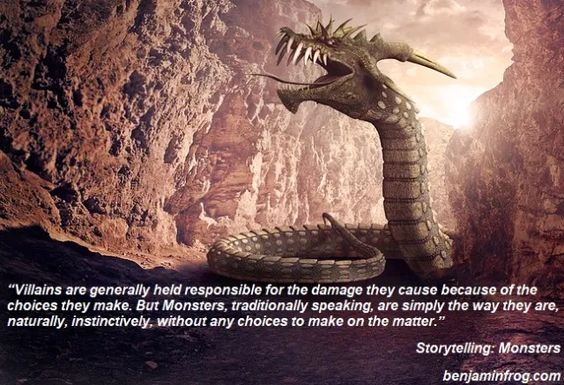Writing sympathetic villains and monsters. Benjamin Collier takes us through the steps to write fantastic scenes with these fictional characters.
Monsters

“Monsters are a different kind of character than simply a Villain, because Villains are generally held responsible for the damage they cause because of the choices they make. But Monsters, traditionally speaking, are simply the way they are, naturally, instinctively, without any choices to make on the matter. They do not do what they do out of evil intent or misguided beliefs, they simply do it because it’s what they are, and nobody blames them for it. This is the case with King Kong and Godzilla. It’s like a force of nature.
It’s like in a disaster movie where nature has gone haywire and sends earthquakes and tornadoes to destroy cities. The people in the film hardly blame the storm for doing what a storm naturally does. Nature is not the villain. But in some disaster movies the storm is “caused” by the unnatural work of scientists prioritizing business and profit over safety, and those people are considered the real villains. The storm is just a result of the villains’ actions. Godzilla was created by nuclear explosions, so the real villain is man.
In some cases the Monster makes a connection with a child or something, and then chooses to fight the villains in order to protect civilians. So it is possible for monsters to become heroes. Many Monsters are considered pure-hearted anyway, especially if they’re simply animals.” Continue reading Ben’s blog …
Sympathetic Villains
“These can be interesting if done right, but you have to be very careful. Sympathetic Villains, as mentioned in the last post, are usually villains who hate themselves, or hate what they’ve become, but they don’t see a way to change. The change usually comes through some intervention on the part of a hero, but not always.
There are right and wrong ways of doing this, and what is right or wrong to you will depend on what fundamental views you hold on the nature of evil. I can only give you advice based on what my views are, but ultimately, tell the story you want to tell as it makes sense in your mind.
The Sympathetic Villain is a pattern in storytelling these days where we see someone we would hold as being inherently evil, but they are not what they seem. They do unspeakable things to innocent people and seem to feel no remorse for it, or they actually feel joy from it, and we as the audience tend to hate them and want to see them punished.
Then the storyteller flips it around on us and shows us something the character had been through sometime before, some sort of horrible childhood or even a single experience or years of experience that desensitized them to those horrors and now, as a direct result, they inflict suffering on others without a twinge of conscience. The audience is then left wondering what real evil is, or if there even is such a thing, if apparently anybody can be turned.” Continue reading Ben’s blog …
You can read more about villains, monsters and hero characters in Ben’s The Storyteller’s Handbook.

And you can see some of Ben’s writing skills in print on his website books page.
Thank you, Ben, for sharing your writing expertise with us.
Happy Writing, everyone!
Lynne
